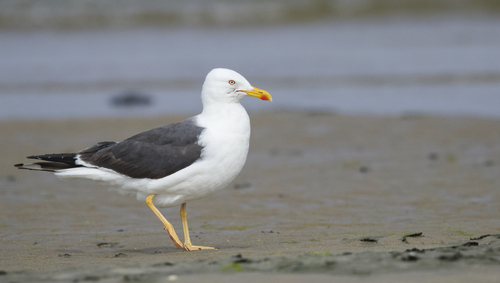
Lesser Black-backed Gull
The Lesser Black-backed Gull (*Larus fuscus*) is a large gull species that breeds on the Atlantic coasts of Europe. It is a migratory bird, wintering from the British Isles south to West Africa. This species plays a significant role in coastal and marine ecosystems, acting as both predator and scavenger. While not currently considered globally threatened, certain populations face regional declines due to various factors. It is a familiar sight in many coastal areas, often seen scavenging around fishing harbors and landfills, showcasing its adaptability.
51-64 cm
Length
124-158 cm
Wingspan
Least Concern
Conservation Status
Distribution
Breeds primarily along the Atlantic coasts of Europe, including Iceland, the British Isles, Scandinavia, and northwestern Russia. Migrates south for the winter, ranging from the British Isles and the North Sea to West Africa and, less commonly, the east coast of North America.
Lifespan
The average lifespan in the wild is around 10-15 years, but some individuals have been recorded living much longer, even exceeding 25 years.
Lesser Black-backed Gull's Habitat
Habitat Types
Coastal cliffs, Rocky islands, Lakes, Rivers, Marshes, Moorlands, Tundra, Urban areas (during migration and winter)
Climate Zones
Temperate, Boreal, Subarctic
Adaptations
Lesser Black-backed Gulls are highly adaptable to various habitats, demonstrating flexibility in their nesting and foraging preferences. They can tolerate a wide range of salinity levels, enabling them to inhabit both coastal and inland freshwater environments.
Variations
Several subspecies are recognized, differing primarily in mantle (back) coloration. These include *L. f. fuscus* (Baltic Lesser Black-backed Gull), *L. f. intermedius* (Dutch Lesser Black-backed Gull), and *L. f. graellsii* (British Lesser Black-backed Gull).
Appearance
Breeding Plumage
Adult breeding plumage features a dark grey to black back (depending on the subspecies), white head and underparts, and yellow legs and bill with a red spot on the lower mandible. Non-breeding adults develop dark streaking on the head and neck.
Seasonal Feather Changes
Plumage changes seasonally, with the head becoming streaked in winter. Juvenile birds have mottled brown plumage, gradually acquiring adult plumage over several years.
Sex Based Plumage Differences
There is minimal sexual dimorphism in plumage, although males tend to be slightly larger and have a heavier bill.
Notable Features
Yellow legs and feet., Red spot on the lower mandible., Dark grey to black back (mantle) – varies by subspecies.
Diet and Feeding
Primary Foods
Fish, Invertebrates, Carrion, Eggs, Chicks of other birds, Garbage
Foraging Behavior
Lesser Black-backed Gulls are opportunistic feeders, employing various foraging techniques. They may catch fish near the surface, scavenge for carrion, steal food from other birds (kleptoparasitism), or forage on landfills.
Specializations
They have a strong bill adapted for tearing flesh and crushing shells. They are also skilled at plunge-diving for fish.
Seasonal Diet Variations
Their diet varies seasonally and geographically depending on food availability. During the breeding season, they may rely more heavily on fish and marine invertebrates, while in winter, they may consume more garbage and carrion.
Behavior
Social Structure
Lesser Black-backed Gulls are often colonial breeders, nesting in large groups, sometimes with other gull species. Outside of the breeding season, they can be found in flocks, particularly at feeding sites.
Communication
Vocalizations (a variety of calls, including a loud 'kee-ow'), Posturing (head-tossing, bill-pointing), Aerial displays
Migration
Most populations are migratory, traveling south for the winter. Some populations, particularly in the southern part of their range, are resident or only partially migratory. The migration routes and distances vary depending on the breeding population.
Territorial or Group Behaviors
They are territorial during the breeding season, defending their nesting site from intruders. Outside of the breeding season, they often form large flocks at roosting and feeding sites.
Conservation
Threats
Habitat loss and degradation, Pollution (including oil spills and plastic ingestion), Climate change (affecting prey availability and nesting sites), Human disturbance, Predation (by introduced predators on breeding colonies)
Protection Programs
International agreements (e.g., the Agreement on the Conservation of Albatrosses and Petrels (ACAP)), Protected areas (e.g., national parks and nature reserves)
Local National Laws
Protected under various national and international laws, including the Migratory Bird Treaty Act in the US (for vagrants) and the Birds Directive in the EU.
Population Trend
Stable overall, but some populations are declining.
Population Estimates
The global population is estimated to be between 720,000 and 970,000 individuals.
Interesting Facts
They are known for their long migrations.
Some individuals travel thousands of kilometers between their breeding and wintering grounds.
They exhibit kleptoparasitism.
They often steal food from other birds, including other gull species and seabirds.
They are highly adaptable.
Their ability to utilize a wide range of food sources and habitats has contributed to their success.
Faqs about Lesser Black-backed Gull
Are Lesser Black-backed Gulls aggressive?
They can be aggressive when defending their nests or young, but generally, they are not a threat to humans unless provoked.
What is the difference between a Lesser Black-backed Gull and a Herring Gull?
Lesser Black-backed Gulls have darker grey or black backs compared to the light grey back of the Herring Gull. Lesser Black-backed Gulls also have yellow legs, while Herring Gulls have pink legs.
Why do gulls have a red spot on their bill?
The red spot is a target for chicks to peck at, stimulating the parent to regurgitate food.
How can I tell the subspecies apart?
The main difference lies in the shade of grey on their back. *L. f. fuscus* has the darkest, almost black, mantle, while *L. f. graellsii* has a lighter slate-grey mantle. *L. f. intermedius* is intermediate in shade.
Copyright @ Nature Style Limited. All Rights Reserved.
 English
English